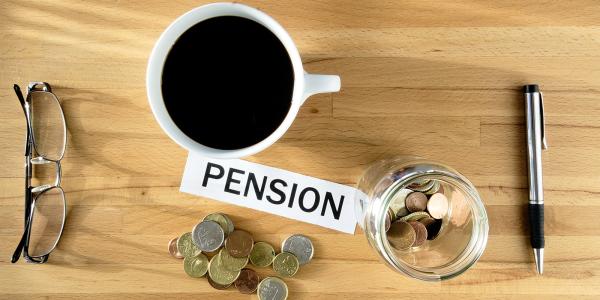Pensions auto-enrolment: contributions
If you are eligible for auto-enrolment and do not choose to opt out, there are certain contribution requirements that must be met. Here we look at how much needs to be paid into your pension under auto-enrolment, and how this might be split between you and your employer.

Content on this page:
Overview
Normally, a percentage (%) of your ‘qualifying earnings’ has to be put into your auto-enrolment pension each pay day.
Note that there are other contribution methods, for example pensionable pay, which is described on the government’s MoneyHelper website.
Your qualifying earnings include your wages or salary, bonuses, commission as well as other items, such as statutory pay, before any tax or National Insurance contributions are deducted.
| Overall total contribution required | Minimum from employer | Potential contribution from you |
| 8% | 3% | 5% |
The above percentages apply to any qualifying earnings you have over £6,240 (for 2024/25) up to the limit of £50,270. The £6,240 and £50,270 yearly amounts translate into the following figures depending on how often you are paid:
| £6,240 a year | £50,270 a year | |
| Weekly | £120 | £967 |
| 2-weekly | £240 | £1,934 |
| 4-weekly | £480 | £3,867 |
| Monthly | £520 | £4,189 |
Note that pension schemes may allow additional regular or one-off contributions to be made into your pot, over and above the minimum percentages outlined above.
Employer contribution
As mentioned in the table above, your employer must make a minimum contribution (currently 3%). However, your employer can choose to pay more. This means that you have to pay less, unless you want to pay more in yourself.
Therefore, the amount you have to pay depends on how much your employer pays. For example, in the tax year 2024/25, the minimum total contribution is 8% of which your employer must pay 3%. Instead, if your employer chose to pay the full 8%, then you would not have to pay anything, unless you wanted to. If your employer pays their minimum amount of 3%, then you must pay 5% as the overall minimum contribution is 8%.
This flexibility means that sometimes, an employer might operate salary sacrifice arrangements for your auto-enrolment pension.
Your employer should tell you how much you will need to contribute. The government’s MoneyHelper website provides a free workplace pension contribution calculator to help work out how much you will have to contribute. Your contributions will reduce your pay, which could lead to an increase in any benefits you are on.
Tax relief for employees
If you do have to contribute, you will normally get tax relief on the contribution. How you receive this tax relief depends on wither your employer is operating a ‘relief at source scheme’ or a ‘net pay scheme’. You should note that your employer’s contributions will not be a taxable benefit on you no matter which tax relief arrangement the pension scheme uses.
Relief at source scheme
If the pension scheme uses a ‘relief at source’ method of tax relief, then the scheme provider is able to claim 20p in tax relief from the government on every 80p you pay in, regardless of how much you earn. This will be paid directly by the government into your pension pot.
The tax relief means that the potential contribution percentage for you, the employee, is as follows – assuming your employer is contributing the minimum of 3%:
- Net contribution (actual amount paid by you, the employee): 4%
- Tax relief claimed from the government by the scheme provider: 1%
- Total gross employee contribution: 5%.
Net pay scheme
Some other pension providers use a different approach to tax relief, known as net pay arrangements. With a net pay pension scheme, any contributions you make will be automatically taken from your pay packet and will lead to a reduction in your take home pay.
Generally speaking, this means employees do not get any tax relief at the time of making the contribution unless their earnings are more than £12,570 (in 2024/25). Check with your employer which type of pension scheme they use.
For more information about tax relief on pension contributions, see our page How tax relief is given on pension contributions.
Where contributions go
Your employer must choose a suitable pension company to receive and invest all the contributions which are made. Your employer will have to give you the details of the pension company it has chosen.
Once you have been auto-enrolled, the pension company will write to you with a welcome pack. This should tell you everything you need to know about being a member of their scheme and how it works, from logging into your online account for the first time (most pension companies allow you to keep track of your pension pot online) to what happens to your money if you die.
The pension company will invest the contributions. Your defined contribution pension ‘pot’ is separate from those of everyone else and so you might be able to make some decisions about where your money is invested if you want to. Any growth within the pension pot is tax-free, but the value of investments can increase or decrease.
For information on what happens if you leave a job see our Workplace pensions page.
The amount of money you have when you retire depends on how much has been paid in and how well the investments have performed. In most schemes when you retire you can take some of your pension as a tax-free lump sum. You can choose how to take the rest, for example as an income or as a further lump sum, but you may have to pay tax on it. You can find out more about your options on our page Pension withdrawals.
Going on maternity leave
If you are about to go on maternity leave, so that you will have a reduced income, you may wonder what happens with pension contributions.
Assuming you are already in a pension scheme before you go on maternity leave, then your own pension contributions will usually be based on the pay you actually receive, for example, your statutory maternity pay.
Your employer’s contributions will be based on your earnings before your maternity leave began.
Employers are required to make contributions for the full 26-week ordinary maternity leave period. If you decide to extend your leave, the employer contributions must continue to the extent there is statutory maternity pay or any other contractual income still being paid (this will usually only be up to 39 weeks).
You can find out more on maternity leave and paternity leave and your pension on the government’s Moneyhelper website.



